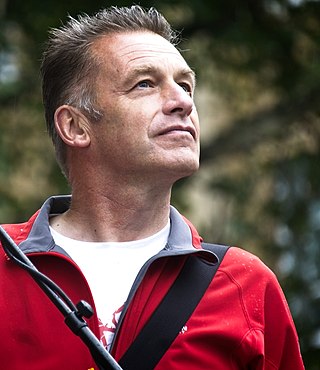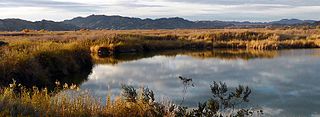Related Research Articles

The spotted owl is a species of true owl. It is a resident species of old-growth forests in western North America, where it nests in tree hollows, old bird of prey nests, or rock crevices. Nests can be between 12 and 60 metres high and usually contain two eggs. It is a nocturnal owl which feeds on small mammals and birds. Three subspecies are recognized, ranging in distribution from British Columbia to Mexico. The spotted owl is under pressure from habitat destruction throughout its range, and is currently classified as a near-threatened species.

Raymond Paul Mears is a British woodsman, instructor, businessman, author and TV presenter. His TV appearances cover bushcraft and survival techniques.

Christopher Gary Packham CBE is an English naturalist, nature photographer, television presenter and author, best known for his television work including the CBBC children's nature series The Really Wild Show from 1986 to 1995. He has also presented the BBC nature series Springwatch, including Autumnwatch and Winterwatch, since 2009.

A nature documentary or wildlife documentary is a genre of documentary film or series about animals, plants, or other non-human living creatures. Nature documentaries usually concentrate on video taken in the subject's natural habitat, but often including footage of trained and captive animals, too. Sometimes they are about wildlife or ecosystems in relationship to human beings. Such programmes are most frequently made for television, particularly for public broadcasting channels, but some are also made for the cinema. The proliferation of this genre occurred almost simultaneously alongside the production of similar television series which is distributed across the world.

Love Nature is a Canadian specialty television channel owned by Blue Ant Media. Originally launched on March 12, 2006, the channel broadcasts documentaries and television series related to wildlife and nature.
Beastmaster is a television series that aired from 1999 to 2002. It was loosely based on the 1982 MGM film The Beastmaster, which was itself loosely adapted from the novel The Beast Master by Andre Norton. The series aired 66 episodes over three complete seasons. It was produced by Coote/Hayes Productions.

Man vs. Wild, also called Born Survivor: Bear Grylls, Ultimate Survival, Survival Game, or colloquially as simply Bear Grylls in the United Kingdom, is a survival television series hosted by Bear Grylls on the Discovery Channel. In the United Kingdom, the series was originally shown on Channel 4, but the show's later seasons were broadcast on Discovery Channel U.K. The series was produced by British television production company Diverse Bristol. The show was premiered on November 10, 2006, after airing a pilot episode titled "The Rockies" on March 10, 2006.

The natural history of Minnesota covers the plant and animal species of the U.S. state of Minnesota. The continental climate and location of Minnesota at the physiographic intersection of the Laurentian and the Interior Plains influences its plant and animal life. Three of North America's biomes converge in Minnesota: prairie grasslands in the southwestern and western parts of the state, the eastern temperate deciduous forests in the east-central and the southeast, and the coniferous forest in the north-central and northeast.

The fauna of Toronto include a variety of different species situated within the city limits. Toronto contains a mosaic of ecosystems that includes forests, rivers, streams, and wetlands, which allows it to support a large variety of fauna. Approximately 87 to 90 per cent of the city's indigenous flora and fauna inhabit the city reside within the Toronto ravine system. The city's ravine system, creeks and rivers are wildlife corridors that allow animals to travel from one area of the city to another. Although most animals in Toronto reside within the ravine system, several animals also live in the city's urban environment and parks.

Animal Mechanicals is a Canadian CGI-animated preschool television series created by Jeff Rosen. Produced by Halifax Film, in association with the CBC and distributed by Decode Entertainment, the series premiered in Canada on CBC Television as part of the Kids' CBC on September 1, 2008. In the United States, it premiered on The Hub on October 11, 2010.
Michael David Cobham was a British film and TV producer and director, best known for the film Tarka the Otter. He was also a first-class cricketer.

Survive This is a Canadian reality television show in which eight teenagers with limited survival skills training are taken into a forest and confronted with a number of survival challenges to test their skills and perseverance. The series aired on YTV in Canada and Cartoon Network in the United States. The show is hosted by Les Stroud, who narrates each episode, provides the teens with survival challenges, and assesses their performance. The show premiered on April 7, 2009, in Canada and on June 17, 2009, in the United States. Cartoon Network ceased to air Survive This after August 19, 2009, and screened the final three episodes only on the network's website.

The Imperial National Wildlife Refuge protects wildlife habitat along 30 miles (50 km) of the lower Colorado River in Arizona and California, including the last un-channeled section before the river enters Mexico. The Imperial Refuge Wilderness, a federally designated, 15,056-acre (60.93 km2), wilderness area is protected within the refuge. It also surrounds the Picacho State Recreation Area. This section of the Colorado River is popular for boating, hiking, fishing, camping, exploring old mining camps and wildlife watching.

Survivor: Borneo, originally known simply as Survivor or Survivor: Pulau Tiga, is the first season of the American CBS competitive reality television series Survivor. The show was filmed from March 13 through April 20, 2000, and premiered on May 31, 2000. The season started with 16 participants tasked with being left to survive in a remote area in Borneo, Malaysia, with minimal tools and supplies. Hosted by Jeff Probst, it consisted of 39 days with consecutive participants being removed by a majority vote. The series was set in the South China Sea on the remote Malaysian island of Pulau Tiga in the state of Sabah, about six miles (10 km) off the north coast of Borneo.

The fauna of the State of California may be the most diverse in the United States of America. Of the Lower 48 conterminous states, California has the greatest diversity in climate, terrain and geology in general. The state's six life zones are the lower Sonoran (desert); upper Sonoran ; transition ; and the Canadian, Hudsonian, and Arctic zones, comprising California's highest elevations. California’s diverse geography gives rise to dozens of different ecosystems, each of which has its own unique native plants and animals. California is a huge state, the 3rd largest in the U.S., and can range broadly in habitat type.

Chris Morgan is a British-born ecologist, conservationist, TV host, filmmaker, podcaster, and author. His ecology and conservation work focuses on bears and other large carnivores worldwide. Over the last 25 years Morgan has worked as a wildlife researcher, wilderness guide, and environmental educator on every continent where bears exist.
Andre-Francois Bourbeau is a noted Canadian survival expert and professor emeritus at the Université du Québec à Chicoutimi. Bourbeau co-founded the survival skills Outdoor Adventure Program at that university and taught there for more than 30 years. The students at the Université du Québec à Chicoutimi have affectionately given Bourbeau the nickname "Doc Survival" due to his skills.

Casey Anderson is an American filmmaker, wildlife naturalist, and television presenter known for translating human relationships with the natural world and wild animals to various audiences. He has been a host and executive producer of the Nat Geo WILD channel television series, Expedition Wild and America the Wild with Casey Anderson, and for raising Brutus the Bear, a grizzly bear that he rescued and adopted as a newborn cub. Brutus and Anderson have appeared in many films, documentaries, television commercials, and live educational shows across the United States.
Frank Cooper Craighead Jr. and John Johnson Craighead, twin brothers, were American conservationists, naturalists, and researchers who made important contributions to the studies of falconry and grizzly bear biology. The brothers were born in Washington, D.C., where both graduated from Western High School in 1935. The brothers began collecting and identifying animals and plants they found alongside the Potomac and soon expanded their interests to birds and hawks. They traveled west in 1934 to begin studying falconry. After World War II, during which they were employed as survival trainers, they each married and resumed their work in falconry. During the 1950s, the Craighead brothers expanded their work to other animals, including many species living in and around Yellowstone, and eventually separated.

Nathaniel "Coyote" Peterson is an American YouTuber, wildlife educator, and host of Animal Planet's series Coyote Peterson: Brave the Wild. He is best known for his YouTube channel Brave Wilderness, which focuses on documenting and educating about animals. Peterson has also become known for videos in which he allows himself to be stung or bitten by various animals, many of them venomous, such as the bullet ant and the executioner wasp.
References
- 1 2 3 "Ellis Entertainment". Archived from the original on 2015-02-14. Retrieved 2015-01-19.
- ↑ "Ellis Entertainment". Archived from the original on 2015-02-14. Retrieved 2015-01-19.
- ↑ "Profiles of Nature" – via www.imdb.com.
- ↑ "Zoos, Captive Breeding and Reintroductions Endangered Species Handbook". Archived from the original on 2015-01-19. Retrieved 2015-01-19.
- ↑ canoeman1961 (11 January 2015). "TVOntario Profiles of Nature - The Red-Tailed Hawk" – via YouTube.
{{cite web}}: CS1 maint: numeric names: authors list (link) - ↑ Nero, Robert W. (1994-06-30). Lady Grayl: Owl With a Mission. Dundurn. ISBN 978-1-4597-1894-4.
- ↑ "PROFILES OF NATURE XI - Telefilm Canada". Archived from the original on 2015-01-19. Retrieved 2015-01-19.
- 1 2 Bourbeau, André-François (2013-05-11). Wilderness Secrets Revealed: Adventures of a Survivor. Dundurn. ISBN 978-1-4597-0697-2.
- ↑ Bourbeau, Andre-Francois; Stroud, Les (11 May 2013). Wilderness Secrets Revealed: Adventures of a Survivor. Dundurn. ISBN 978-1459706965.
- ↑ "Meet André-François Bourbeau: wilderness survival pioneer - University Affairs".
- ↑ "Wilderness Secrets Revealed".
- ↑ "Search Results - Entertainment". www.msn.com.
- ↑ Encyclopedia, Canadian Theatre. "Canadian Theatre Encyclopedia - Dainard, Neil". www.canadiantheatre.com.